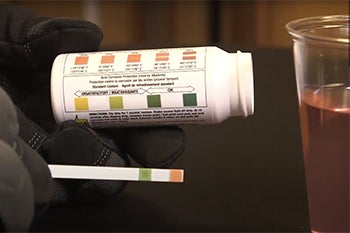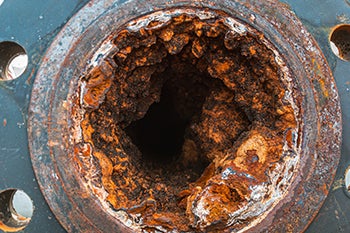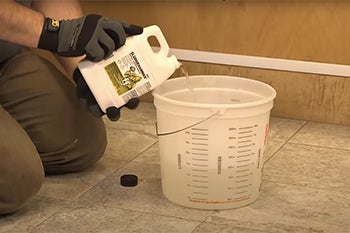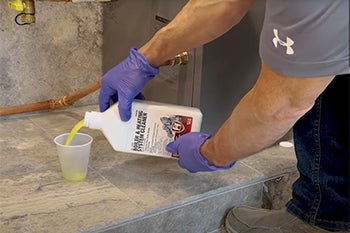Hydronic heating systems offer efficient, cost-effective, and comfortable heating in large homes and commercial buildings. Proper maintenance is essential to ensure the system’s longevity.
For a hydronic heating system to operate properly, the water must maintain the correct pH level. If the water pH is not regularly tested and properly maintained, minerals can build up inside the system components.
Or the water can turn acidic and attack the system’s metallic components and piping from the inside out. Rust or scale will form, reducing system performance over time. Enough buildup can essentially stop the operation of the system altogether.
Below, we’ll explore the importance of maintaining a perfect pH level balance in your hydronic heating system and review the steps involved in testing pH levels as well as how to adjust them. We will also highlight some essential products from the Hercules range of products to help you make sure your heating system stays in tip-top shape.
What is pH, and what should the level be in a hydronic heating system?
Historically denoting “potential of hydrogen,” pH indicates how acidic or basic the water inside a hydronic heating system is. According to usgs.gov, the universal reading for pH goes from 0-14, with 7 being neutral. Less than 7 indicates acidity; greater than 7 indicates a base.
- Examples of items that have a pH of less than 7 are black coffee (pH=5), grapefruit juice, soda, or tomato juice (2.5-3.5), and lemon juice or vinegar (2).
- Examples of items that have a pH of greater than 7 would be seawater (8), baking soda (9.5), ammonia solution (10.5-11.5), and liquid drain cleaner (14).
pH is an important indicator that water is changing chemically. Hydronic systems need to maintain a perfect pH level balance: A pH that goes too high or too low can drastically impact a system.
The correct level will depend on the metallic composition of the heat exchanger. Some recommended pH levels range from 8 to 8.5. Systems with cast iron, stainless steel, or copper exchangers are resilient and usually have a wide range of acceptable levels. Aluminum is more prone to corrosion and may require a specific pH.
We recommend checking the system’s installation and operation manual to determine the acceptable pH range.
How to test the pH level in hydronic heating systems
Start by doing a visual reading: Open the drain valve and bleed off some liquid. If it appears clear, proceed with a pH test.
Hercules Cryo-Tek Test Strips, available in packs of 6 to 10 color-coded and disposable test strips, can simultaneously check both the level of freeze protection (propylene glycol) and the level of corrosion protection in a system. If you need a more precise reading for an aluminum system, use a digital pH meter.

To conduct the test, drain some water from the hydronic system and dip one of the pH test strips into the sample. Once a bit of color pops up, compare the strip to the color chart on the bottle to determine the pH level.
- If the pH levels are too high, you’ll start to notice scale or limescale buildup in the system over time. Too much mineral buildup will restrict the system’s water flow. Essentially, the effectiveness of the system is lessened.
- If the pH levels are too low, the water has turned acidic. This leads to rust and corrosion — a serious problem since boilers are typically made of copper, cast iron, and aluminum. As mentioned earlier, enough corrosion can stop system operation altogether.

How to adjust the pH level in hydronic heating systems
If the test strips or digital meter indicates that the pH level is off, follow these steps:
- Drain about a gallon of liquid from the boiler and dispose of it.
- Fill a container with a quart of corrosion inhibitor, such as Hercules® Sludgehammer™ Universal Corrosion Inhibitor, and three quarts of fresh water.
- Pump this solution into the system and allow it to circulate for about half an hour.
- Test again. Usually, a single dose of inhibitor does the job. But if the reading is still too low, repeat the process.
A corrosion inhibitor like Hercules® Sludgehammer™ will help balance out the pH. But if the buildup or corrosion has been going on for several years, the system will probably not recover with this treatment. Instead, you must use a cleaner to flush the system to maximize boiler efficiency.

Hercules® Boiler and Heating System Cleaner is formulated to clean and condition both steam and hot-water hydronic systems by removing rust, scale, and sludge. The cleaner can also free and lubricate zone valves and help stop priming and foaming with a special anti-foam agent. Ultimately, it is a liquid cleaner and corrosion-prevention treatment.
The Hercules® Sludgehammer System Restorer & Noise Reducer is another option for maintaining a hydronic heating system. More aggressive than the system cleaner, it also cleans and reduces kettling (bubbling and banging) while restoring system efficiency. You can pair this product with a corrosion inhibitor for annual heating system maintenance checks.

Hydronic heating systems are closed, so there are usually no external signs of corrosion. That makes it difficult to spot an equipment leak — unless, of course, water is visibly running onto the floor. (If so, corrosive water inside the boiler is a likely cause.)
This general lack of immediate visibility is why testing hydronic systems annually is vital. If your locale has hard water or other conditions that cause the water to be more acidic, testing should be done twice a year.
The lack of visibility is also why sampling the water, as described above, is a must: It is the best way to tell if anything is wrong. If rust or sludge appears in your sample, you should test and replace the water.
In conclusion, you must test the pH of boiler systems to maximize their efficiency, using products that can make monitoring pH levels simple and easy. If this testing uncovers damage to the system, there are also ways to alleviate and fix that damage.
Your hydronic heating system is a vital component of your home or commercial building, and proper maintenance is essential to save money on energy bills, reduce the frequency of costly repairs, and increase the system’s lifespan.
To take the steps needed to maintain your hydronic heating system, check out our detailed project guide: How to Keep a Well-Maintained Hydronic Heating System with Hercules Heating Chemicals and Antifreeze Products